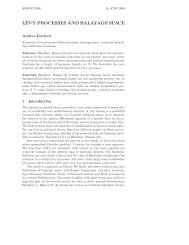Degenerate parabolic stochastic partial differential equations
Degenerate parabolic stochastic partial differential equations
Degenerate parabolic stochastic partial differential equations
You also want an ePaper? Increase the reach of your titles
YUMPU automatically turns print PDFs into web optimized ePapers that Google loves.
4326 M. Hofmanová / Stochastic Processes and their Applications 123 (2013) 4294–4336<br />
Thus, according to the Banach–Alaoglu theorem, (39) is obtained (up to subsequence). However,<br />
it still remains to show that the weak* limit ˜m is actually a kinetic measure. The first point of<br />
Definition 2.1 is straightforward as it corresponds to the weak*-measurability of ˜m. The second<br />
one giving the behavior for large ξ follows from the uniform estimate (28). Indeed, let (χ δ ) be a<br />
truncation on R, then it holds, for p ∈ [2, ∞), that<br />
<br />
<br />
Ẽ<br />
|ξ| p−2 d ˜m(x, t, ξ) ≤ lim inf Ẽ<br />
|ξ| p−2 χ δ (ξ) d ˜m(x, t, ξ)<br />
T N ×[0,T ]×R<br />
δ→0 T N ×[0,T ]×R<br />
<br />
= lim inf lim Ẽ<br />
|ξ| p−2<br />
δ→0 n→∞<br />
T N ×[0,T ]×R<br />
× χ δ (ξ) d ˜m n (x, t, ξ) ≤ C,<br />
where the last inequality follows from (28) and the sequel. As a consequence, ˜m vanishes for<br />
large ξ. The remaining requirement of Definition 2.1 follows from [6, Theorem 3.7] since for<br />
any ψ ∈ C 0 (T N × R)<br />
<br />
t −→<br />
ψ(x, ξ) d ˜m(s, x, ξ)<br />
T N ×[0,t]×R<br />
is F˜<br />
⊗ B([0, T ])-measurable and ( F˜<br />
t )-adapted for the filtration introduced below after this<br />
proof.<br />
Finally, by the same approach as above, we deduce that there exist kinetic measures õ 1 , õ 2<br />
such that<br />
ñ n 1<br />
w ∗<br />
w ∗<br />
−→ õ 1 , ñ n 2 −→ õ 2 in L 2 w ( ˜Ω; M b (T N × [0, T ] × R))-weak ∗ .<br />
Then from (28) we obtain<br />
T <br />
<br />
Ẽ σ (x)∇ũ<br />
n 2 dx dt ≤ C;<br />
0 T N<br />
hence the application of the Banach–Alaoglu theorem yields that, up to subsequence, σ ∇ũ n<br />
converges weakly in L 2 ( ˜Ω × T N × [0, T ]). On the other hand, from the strong convergence<br />
given by Proposition 4.10 and the fact that σ ∈ W 1,∞ (T N ), we conclude using integration by<br />
parts, for all ψ ∈ C 1 (T N × [0, T ]), that<br />
T <br />
T <br />
σ (x)∇ũ n ψ(x, t) dx dt −→ σ (x)∇ũψ(x, t) dx dt, ˜P-a.s.<br />
0 T N 0 T N<br />
Therefore<br />
σ ∇ũ n<br />
w<br />
−→ σ ∇ũ,<br />
in L 2 (T N × [0, T ]), ˜P-a.s.<br />
Since any norm is weakly sequentially lower semicontinuous, it follows for all ϕ ∈ C 0 (T N ×<br />
[0, T ] × R) and fixed ξ ∈ R, ˜P-a.s.,<br />
T <br />
<br />
T <br />
σ (x)∇ũ 2 ϕ 2 <br />
(x, t, ξ) dx dt ≤ lim inf σ (x)∇ũ<br />
n 2 ϕ 2 (x, t, ξ)dxdt<br />
0 T N n→∞ 0 T N<br />
and by the Fatou lemma<br />
T T N<br />
0<br />
<br />
σ (x)∇ũ 2 ϕ 2 (x, t, ξ) dδũ=ξ dx dt<br />
R



